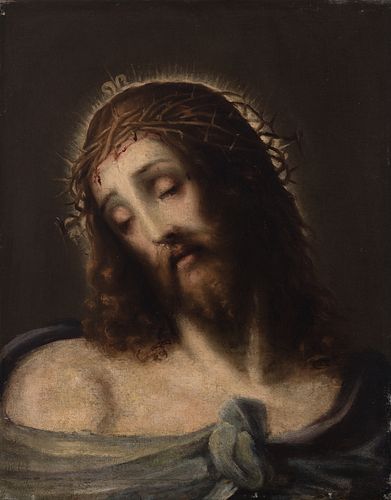Italian school; second half of the seventeenth century. "Christ of sorrows". Oil on canvas. Relined.
Lot 34
About Seller
Setdart Auction House
Carrer Aragó 346
Barcelona
Spain
Setdart Subastas was born in 2004 and is currently the first online art auction in Spain with solidity, prestige and reliability guaranteed by our more than 60,000 users. Setdart has a young, dynamic and enterprising team ready to successfully manage the purchase and sale of art works through custom...Read more
Estimate:
EUR€2,500 - EUR€3,000
$2,604.17 - $3,125
Absentee vs Live bid
Two ways to bid:
- Leave a max absentee bid and the platform will bid on your behalf up to your maximum bid during the live auction.
- Bid live during the auction and your bids will be submitted real-time to the auctioneer.
Bid Increments
| Price | Bid Increment |
|---|---|
| EUR€0 | EUR€10 |
| EUR€200 | EUR€25 |
| EUR€500 | EUR€50 |
| EUR€1,000 | EUR€100 |
| EUR€3,000 | EUR€200 |
| EUR€5,000 | EUR€500 |
| EUR€10,000 | EUR€1,000 |
| EUR€20,000 | EUR€2,000 |
| EUR€50,000 | EUR€5,000 |
About Auction
By Setdart Auction House
Nov 3, 2021
Set Reminder
2021-11-03 08:00:00
2021-11-03 08:00:00
America/New_York
Bidsquare
Bidsquare : OLD MASTERS
https://www.bidsquare.com/auctions/setdart-auction-house/old-masters-7786
Setdart Auction House sofia@setdart.com
Setdart Auction House sofia@setdart.com
- Lot Description
Italian school; second half of the seventeenth century. "Christ of sorrows". Oil on canvas. Relined. Presents repainting and Elizabethan frame, c. 1850 with damage. Measurements: 57 x 44 cm; 66 x 55 cm (frame). The invocation of the Christ of sorrows, usually represented the figure of Jesus, naked, except for the cloth of purity, located in the lower area, although in this case only the bust of Jesus is appreciated, with a blue cloak knotted to the chest. It is a compassion that arises as a result of the Calvary process suffered by Jesus. Of simple and clear composition, with the face of Christ in the foreground, the absence of narrative details deepens the expressive power and pathos, designed to move the spirit of the faithful who pray before the image, within a tremendist sense very typical of the baroque in Catholic countries. The theme of Ecce Homo belongs to the cycle of the Passion, and precedes the episode of the Crucifixion. Following this iconography, Jesus is presented at the moment when the soldiers mock him, after crowning him with thorns, dressing him in a purple robe symbolic of the Passion and placing a reed in his hand, kneeling and exclaiming "Hail, King of the Jews!". The words "Ecce Homo" are those pronounced by Pilate when presenting Christ before the crowd; their translation is "behold the man", a phrase by which he mocks Jesus and implies that the power of Christ was not such in front of that of the leaders who were judging him there. In this case the reed is not appreciated, but it is true that the work keeps a great similarity with the iconographic patterns used in the representation of the Ecce Homo. Christ is represented bust-length, with a cloak, which in this particular case is not red, as is usually the case. Dressed with the crown of thorns and with a sorrowful attitude. It is true that the work stands out for the softness of the forms, and the tonal transition of the chromatic range by using colors of a soft palette. Although it should be noted that this characteristic can only be appreciated in the representation of the Christ, since the luminosity given off by the white flesh tones creates an expressive contrast with the dark background.
- Shipping Info
-
In-house shipping available. Please inquire at admin@setdart.com.
-
- Buyer's Premium



 EUR
EUR CAD
CAD AUD
AUD GBP
GBP MXN
MXN HKD
HKD CNY
CNY MYR
MYR SEK
SEK SGD
SGD CHF
CHF THB
THB
















